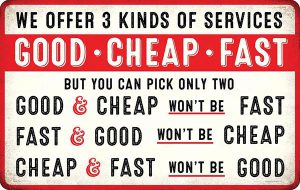In Part 1 of this series, we talked about five things to do to help you choose the right graphic designer to partner with your nonprofit organization or charity.
- Clearly Define Your Needs
- Review the Portfolio
- Evaluate Their Experience Working with Nonprofits
- Request References
- Consider Communication & Collaboration
(Didn’t get to read that article yet? Click here to check it out now.)
Those first five steps create a great foundation for narrowing down who you might be looking for. But there’s still more to consider whether you’re evaluating an existing contractor or agency relationship or considering signing with someone new.
Budget Considerations
We all have budgets to work within (or at least we should!), but finding the perfect graphic designer involves more than just dollars and cents. While it’s important to consider affordability, prioritize quality and expertise as well (we talk about that balance more in this article).

Discuss your budget constraints upfront and ensure the designer can work within your financial constraints. Remember, finding the right fit is worth every penny! A graphic designer in the United States may quote their work at $30-$150+/hour, depending on his or her level of education, experience, expertise, and specialization as well as taking into account the demand for his or her services.
It’s also worth noting that not all graphic designers work at an hourly rate—some prefer to quote projects, based on the expertise required to complete the project. (You’re not always paying them for their time spent on a specific item… sometimes you’re paying them for the decades they’ve spent getting learning how to be excellent and efficient.)
Ask:
- What is the designer’s hourly rate, and is it commensurate with the quality of work and expertise shown in the portfolio?
- How much is our organization willing to invest in expertise and quality?
- Does the designer or agency offer any discounts for nonprofit organizations?
- What mark-ups should be expected if the designer or agency manages other services for you (expect 10-15% or additional fees)?
Timelines and Deadlines
Time is of the essence, especially when it comes to nonprofit campaigns and events. Ensure the graphic designer can deliver work within your required timeframes. Discuss project timelines and deadlines upfront to avoid any surprises down the road. By setting clear expectations, you’ll be on track for timely and impactful designs.
(As mentioned in Part 1, this is a great subject to bring up with the designer’s references.)
Ask:
- How far in advance does the designer prefer to schedule projects? How much notice is required to book this designer’s time?
- What’s the typical turnaround time for your type of project?
Contracts, Proposals, & Agreements
A well-drafted contract or agreement is essential to protect both parties’ interests and foster a smooth working relationship. A project proposal and/or contract from the designer should outline project details, deliverables (what the designer will provide to you—print-ready files or native files), timelines, payment terms (including any deposits required), and ownership of the final designs. You should expect large projects to require a 10-50% deposit.
NOTE: Your designer SHOULD require a contract, even for pro-bono or gratis projects. Be wary of any designer who doesn’t require a contract, especially if they also insist on pre-payment.
If your organization requires a noncompete agreement or confidentiality agreement, be sure to let the designer or agency know early in the process. Keep in mind that not all designers or agencies are willing or able to sign these types of agreements. Most designers require an agreement that allows them to use creative work done under contract in their portfolio and for promotional purposes.
With a clear agreement in place, you can embark on this creative journey with peace of mind.
Ask:
- Is the designer willing to provide an example contract or proposal so you can review the wording?
- Does your organization require noncompete or confidentiality agreements for contractors?
- Do you want a subscription-style agreement (monthly, quarterly, etc.) for billing or do you want to be billed for each project individually as they are completed?
- What are the cancelation terms of the agreement? (Just in case.)
Adaptability
Nonprofits often face shifting needs and unexpected challenges—preaching to the choir here, amiright? Finding a graphic designer who embraces flexibility and adaptability is key. That said, it isn’t a virtue to keep changing the goal-posts… Expect additional fees if you change the scope of your project or have multiple rounds of revisions.
Look for someone who is open to making adjustments during the design process and can seamlessly adapt to your evolving requirements. Together, you’ll navigate the twists and turns and create something remarkable.
Ask:
- What are this designer’s terms for additional revisions or scope change to the project?
- Can this designer “go with the flow” of our organization? (See below for more on that.)
Chemistry
Call it “vibes” or the “it factor”… but there’s a special “something” that happens when you meet with the right person—a kindred spirit who shares your passion for your mission and goals. When choosing a graphic designer, trust your instincts and consider the chemistry between them and your team. Establishing a good rapport and feeling comfortable working together can make the design process more enjoyable and productive.
You can’t expect good work from the partnership if anything feels “off”.
Ask:
- Would you look forward to dealing with this person on a regular basis… or would you dread it?
- Do you feel respected and listened-to?
- Do this person’s values align with your mission and goals?
- Can you confidently entrust your organization’s brand and public face to this designer?
We know that choosing the perfect graphic designer for your nonprofit can be an exciting and… somewhat intimidating process.
By following these best practices, you’ll increase your chances of finding a talented designer who understands your mission, meets your design needs, and becomes an invaluable partner in your organization’s success. Gear up for an adventure filled with creativity, collaboration, and visual storytelling—it’s time to bring your nonprofit’s vision to life!
And, yes, of course, we’re hoping that you’ve been evaluating us as you’ve been reading through this series. We’ve specialized in nonprofit communication and creative services for almost two decades!





1 Comment